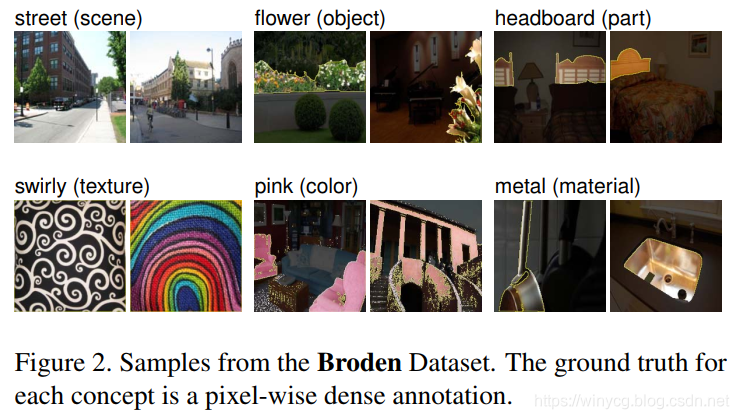引言
作者提出了量化网络latent representation可解释性的框架:评估单一隐藏单元与语义概念的对齐关系。给定一个CNN,可以对某一卷积层的隐藏单元的语义进行打分。语义具有如下的标签:objects(目标),parts(物体的一部分),scenes(场景),textures(纹理),materials(材料),color(颜色)。 Broadly and Densely Labeled Dataset (Broden) 收集了多个数据集的图片并进行了密集的pixel-wise的标注,除了纹理(texture)和场景(scene)是对整体图像的标注,部分例子如下所示:

本文阐述了一些可解释性的结论:
- 可解释性是与坐标轴对齐(axis-aligned)的,对表示(representation)进行翻转(rotate),网络的可解释能力会下降,但是分类性能不变。
- 越深的结构可解释性越好,ResNet>VGGNet>GoogleNet>AlexNet
- 对于训练数据集的可解释性,Places > ImageNet,因为一个场景(scene)会包含多个目标,因此有益于多个目标检测器(object detectors)出现来识别场景。
- 对训练条件的可解释性,训练论数越多越好。与初始化无关,dropout会增强可解释性。Batch normalization会降低可解释性,百化(whiten)操作会平滑缩放问题并且rotate中间特征的轴。
方法

对于给定CNN衡量语义对齐的单元。上图中探测最后卷积层的一个单元的表现。
对于一个给定的输入图像
x
x
x,某一卷积层的第
k
k
k个单元的激活图是
A
k
(
x
)
A_{k}(x)
Ak(x)。单元的激活分布为
α
k
\alpha_{k}
αk,上分位点
T
k
T_{k}
Tk通过
P
(
α
k
>
T
K
)
=
0.005
P(\alpha_{k}>T_{K})=0.005
P(αk>TK)=0.005在每个spatial位置上。如上图所示,首先对低像素的单元激活图
A
k
(
x
)
A_{k}(x)
Ak(x)进行上采样到
S
k
(
x
)
S_{k}(x)
Sk(x)为输入图像像素大小,之后和输入像素的标注mask
L
c
L_{c}
Lc进行比较,其中
c
c
c是某一个语义概念。
S
k
(
x
)
S_{k}(x)
Sk(x)进行一个阈值的二值分割:
M
k
(
x
)
≡
S
k
(
x
)
≥
T
k
(
x
)
M_{k}(x)\equiv S_{k}(x)\geq T_{k}(x)
Mk(x)≡Sk(x)≥Tk(x)。计算
M
k
(
x
)
∩
L
c
(
x
)
M_{k}(x)\cap L_{c}(x)
Mk(x)∩Lc(x)通过IoU来得到单元
k
k
k对于概念
c
c
c的分数:
I
o
U
k
,
c
=
∑
∣
M
k
(
x
)
∩
L
c
(
x
)
∣
∑
∣
M
k
(
x
)
∪
L
c
(
x
)
∣
IoU_{k,c}=\frac{\sum{|M_{k}(x)\cap L_{c}(x)|}}{\sum|M_{k}(x)\cup L_{c}(x)|}
IoUk,c=∑∣Mk(x)∪Lc(x)∣∑∣Mk(x)∩Lc(x)∣
我们认为单元
k
k
k对于概念
c
c
c作为一个检测器如果
I
o
U
k
,
c
IoU_{k,c}
IoUk,c超过了阈值。文中作者使用阈值
0.04
0.04
0.04。注意单个单元可能是多个概念的检测器,于是作者选择排名最好的label。量化某层的可解释性,我们count对齐于单元的独特概念的数量,称这个指标为the number of unique detectors,将某层可以作为detector的单元数量定义为the number of detectors.
pytorch实现
作者提供了Github链接:https://github.com/CSAILVision/NetDissect-Lite
在这里重点说明如何使用自己的模型进行dissection,注意首先要得到pre-trained权重文件。
(1)将模型module代码放在loader/下,如新建文件lenet.py:
import torch.nn as nn
import torch.nn.functional as F
import torch
class LeNet(nn.Module):
def __init__(self, num_classes=1000):
super(LeNet, self).__init__()
self.features = nn.Sequential(
nn.Conv2d(3, 64, 3),
nn.ReLU(inplace=True))
self.fc = nn.Linear(64, num_classes)
def forward(self, x):
out = self.features(x)
out = F.adaptive_avg_pool2d(out, (1, 1))
out = out.view(out.size(0), -1)
out = self.fc(out)
return out
(2)修改loader/下的model_loader.py,用于加载自己的lenet模型:
在settings.py里加入IS_TORCHVISION变量,用于标识是不是torchvision中已有的模型。
import settings
import torch
import torchvision
from .lenet import LeNet
def loadmodel(hook_fn):
if settings.IS_TORCHVISION:
if settings.MODEL_FILE is None:
model = torchvision.models.__dict__[settings.MODEL](pretrained=True)
else:
checkpoint = torch.load(settings.MODEL_FILE)
if type(checkpoint).__name__ == 'OrderedDict' or type(checkpoint).__name__ == 'dict':
model = torchvision.models.__dict__[settings.MODEL](num_classes=settings.NUM_CLASSES)
if settings.MODEL_PARALLEL:
state_dict = {str.replace(k, 'module.', ''): v for k, v in checkpoint[
'state_dict'].items()} # the data parallel layer will add 'module' before each layer name
else:
state_dict = checkpoint
model.load_state_dict(state_dict)
else:
model = checkpoint
else:
checkpoint = torch.load(settings.MODEL_FILE)
model = LeNet(num_classes=settings.NUM_CLASSES)
param_dict = {} # 新的pre-trained权重文件,因为直接load checkpoint可能会引起组件名称不一致问题
for k, v in zip(model.state_dict().keys(), checkpoint['net'].keys()):
param_dict[k] = checkpoint['net'][v]
model.load_state_dict(param_dict)
for name in settings.FEATURE_NAMES:
model._modules.get(name).register_forward_hook(hook_fn)
if settings.GPU:
model.cuda()
model.eval()
return model
(3)settings.py文件设置如下:
######### global settings #########
GPU = True # running on GPU is highly suggested
TEST_MODE = False # turning on the testmode means the code will run on a small dataset.
CLEAN = True # set to "True" if you want to clean the temporary large files after generating result
MODEL = 'lenet' # model arch: resnet18, alexnet, resnet50, densenet161
DATASET = 'imagenet' # model trained on: places365 or imagenet
QUANTILE = 0.005 # the threshold used for activation
SEG_THRESHOLD = 0.04 # the threshold used for visualization
SCORE_THRESHOLD = 0.04 # the threshold used for IoU score (in HTML file)
TOPN = 10 # to show top N image with highest activation for each unit
PARALLEL = 1 # how many process is used for tallying (Experiments show that 1 is the fastest)
CATAGORIES = ["object", "material", "part","scene","texture","color"] # concept categories that are chosen to detect: "object", "part", "scene", "material", "texture", "color"
OUTPUT_FOLDER = "result/pytorch_"+MODEL+"_"+DATASET # result will be stored in this folder
########### sub settings ###########
# In most of the case, you don't have to change them.
# DATA_DIRECTORY: where broaden dataset locates
# IMG_SIZE: image size, alexnet use 227x227
# NUM_CLASSES: how many labels in final prediction
# FEATURE_NAMES: the array of layer where features will be extracted
# MODEL_FILE: the model file to be probed, "None" means the pretrained model in torchvision
# MODEL_PARALLEL: some model is trained in multi-GPU, so there is another way to load them.
# WORKERS: how many workers are fetching images
# BATCH_SIZE: batch size used in feature extraction
# TALLY_BATCH_SIZE: batch size used in tallying
# INDEX_FILE: if you turn on the TEST_MODE, actually you should provide this file on your own
if MODEL != 'alexnet':
DATA_DIRECTORY = 'dataset/broden1_224'
IMG_SIZE = 224
else:
DATA_DIRECTORY = 'dataset/broden1_227'
IMG_SIZE = 227
NUM_CLASSES = 1000
IS_TORCHVISION = False
if MODEL == 'resnet50':
FEATURE_NAMES = ['layer4']
MODEL_FILE = None
MODEL_PARALLEL = False
elif MODEL == 'densenet169':
FEATURE_NAMES = ['features']
MODEL_FILE = None
MODEL_PARALLEL=False
elif MODEL == 'lenet':
FEATURE_NAMES = ['features']
MODEL_FILE = '/home/ws/winycg/mbagnet/checkpoint/LeNet.pth.tar' # 预训练权重文件
if TEST_MODE:
WORKERS = 1
BATCH_SIZE = 4
TALLY_BATCH_SIZE = 2
TALLY_AHEAD = 1
INDEX_FILE = 'index_sm.csv'
OUTPUT_FOLDER += "_test"
else:
WORKERS = 12
BATCH_SIZE = 16
TALLY_BATCH_SIZE = 16
TALLY_AHEAD = 4
INDEX_FILE = 'index.csv'





















 581
581











 被折叠的 条评论
为什么被折叠?
被折叠的 条评论
为什么被折叠?








